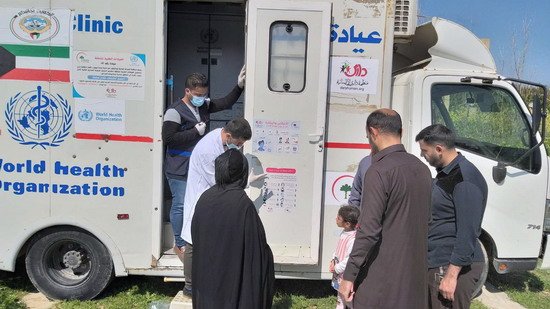During the 1970s and 1980s, Iraq’s primary care-based health system was recognized as one of the best in the region. Two decades after the US-led invasion, it is in ruins, scarred by decades of war and economic sanctions. Health services in Iraq remain unevenly distributed and burdened by a critical shortage of health workers, infrastructure, and supplies.
Efforts to rebuild the health system were significantly affected by the US coalition’s tendency to implement measures and policies without engaging local groups and experts. This approach, which leaned towards commodifying health, has resulted in many areas of Iraq, especially rural ones, lacking access to properly equipped facilities.
This situation is aggravated by long gaps in constructing new health infrastructure. According to a 2013 review of health services in the country, over 50% of the hospitals in Iraq were constructed during the 1970s and 1980s. A report published six years later by Riyadh Lafta and Maha Al-Nuaimi highlighted that no public hospital was built in Iraq between 1986 and 2019, the time when the article was published.
Muntather Hassan, the author of a report on the right to health in Iraq published in the Arab Watch Report 2023, offers a similar description of the situation. He explains that health facilities in Iraq are concentrated in areas built during the 1970s and 1980s. The neighborhoods and areas which were populated afterwards are confronted with a different reality. “There are districts with 500,000 people, and they don’t have a single hospital,” he says.
In the accounts of corporate media, the sluggish pace of rebuilding hospitals and healthcare facilities has been primarily attributed to local corruption. Nevertheless, local activists emphasize that even initiatives led by high-income countries or private contractors have struggled to yield good results. For instance, in 2004, the US signed a USD 243 million contract with Parsons Delaware to construct 150 primary healthcare centers in Iraq. Five years later, a report by the Special Inspector General for Iraq Reconstruction found that the number of centers had fallen to 133. By then, some health centers were still incomplete, and those that were built were of poor quality. At the same time, the construction had cost more than USD 100 million more than expected
Inequalities are not limited to the physical distribution of health facilities. “For example, in the smaller cities, the number of public and private hospitals is somewhere in correlation with the number of people. But the quality is something that needs to be discussed,” Hassan says.
Read: Climate breakdown threatens food security and health in Iraq
Access to health care is particularly problematic in rural areas. Hassan highlights the absence of health services and the challenge this poses to people living in villages scattered across 10 to 15 kilometers, often sharing a single, ill-equipped health center. For them, accessing health care represents a feat.
Private sector seizes more power
While primary healthcare remains weakened, the private sector has expanded significantly over the past decade, with notable growth in niche areas such as cosmetic medicine and laboratory diagnostics. Hassan sees laboratories marketing tests directly to individuals, a practice he compares to promoting a product, as something quite specific to Iraq. The tests provided through this strategy might be of extremely limited use to the people, but they have proven to be a good way to increase profits. In most cases, they cost less than other medical procedures, making them an easy path to earnings.
The influence of the private sector over health in Iraq is not limited to health services alone, but it also extends to medical education. Most private universities in Iraq have departments dedicated to pharmacy or dentistry, as the standards to open them are more lax in comparison to other medical studies. Data from dental and pharmacy associations recalled by Hassan shows that more people are trained in these fields than Iraq actually needs while the country struggles with high emigration rates of health workers.
A 2008 report by Medact estimated that up to 75% of nurses, doctors, and pharmacists left their jobs in the first five years of the US invasion. The overall trend hasn’t changed much since, says Hassan, reflecting on many students and professionals who plan to emigrate to Europe or the US from very early in their career. Considering the high workload faced by young doctors in the public system — up to 80 hours a week — their intentions are easy to understand.
Meanwhile, government expenditure on health remains around 4% of the national budget, far below what is needed to provide support for a robust public health system. Instead, says Hassan, the security sector remains a priority at both national and international levels. The funds allocated by the US, the European Union, and international financial institutions to support peace and stabilization efforts have a particular focus. “It’s not about the community or peace, not [about] the services, but the security and military. It’s a global direction to stabilize Iraq in security terms,” concludes Hassan.
The West’s focus on securitization is in turn pushing the Iraqi government even more towards neoliberal policies and divestment from public services, strengthening the position of the private health sector.
People’s Health Dispatch is a fortnightly bulletin published by the People’s Health Movement and Peoples Dispatch. For more articles and to subscribe to People’s Health Dispatch, click here.





